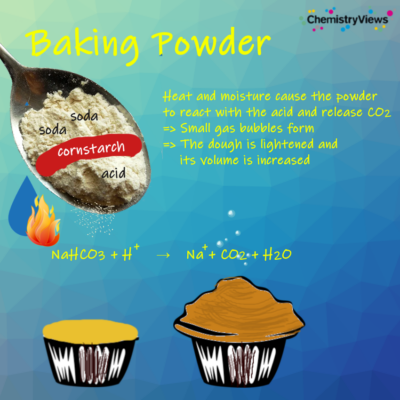Springtime in the Northern Hemisphere is full of festivals: both religious and non-religious celebrations of the changing seasons. One thing many of these celebrations have in common is food. This article will look at the chemistry behind some of the most popular spring festival foods, as well as investigate the chemistry of some plant-based alternatives.
1 Eggs
Of course, eggs are one of the first foods to come to mind at this time of year, being not only a symbol of new beginnings and rebirth and also being fun to decorate and hunt for at Easter time. ChemistryViews has already produced a comprehensive overview of the chemistry behind eggs, which you can find in [1].
Vegans don’t have to miss out on egg decorating, as ceramic or wooden eggs that can be dyed or painted are now widely available.
2 Chocolate
Alongside real eggs, chocolate eggs and other chocolate goodies are also hugely popular at this time of year. The principal ingredient in most chocolate we consume is cocoa butter, which is mainly composed of various triglycerides formed from combinations of palmitic acid, oleic acid, and stearic acid. Milk is commonly added to chocolate to give a smoother mouthfeel, as it acts as a solvent for the fats and sugars in cocoa butter, and to soften chocolate’s bitter edge.
The arrangement of the fat molecules in chocolate gives rise to specific textures and properties. Cocoa butter can crystallize into six polymorphic forms, I to VI, reflecting different arrangements of the fat crystals within the chocolate [2]. Polymorph I is formed by cooling melted chocolate very quickly, for example, in a freezer. It is soft, crumbly, and has “blooms” of fat on the surface; the white marks you sometimes see on old or improperly stored chocolate.
Polymorph VI, however, results from storage of polymorph V for long periods or in the cold, and can also give rise to blooms of fat on its surface.
Polymorph V is the ideal form for chocolate, and this is why good chocolate is tempered slowly at room temperature, giving it the optimal conditions for cooling at the best rate to produce β crystals, the characteristic crystals of this polymorph, instead of the other crystals which can’t form at room temperature. These crystals in polymorph V give the chocolate a smooth, melt-in-the-mouth texture and a desirable “snap” when broken. Achieving this velvety but crisp finish by perfectly aligning fat crystals is quite the artform, as any chemist who has attempted to grow neat and ordered crystals in the lab will appreciate.
3 Lamb
It’s not just sweet treats that are enjoyed during spring festivals; meat, and in particular lamb, is also a common feast food. Key to the deliciousness of meat is the Maillard reaction, which gives that deliciously crisp and tasty outer coating on well-cooked meat and imparts a myriad of flavors to the meat. How does it work?
The Maillard reaction is a non-enzymatic reaction between the amino group of amino acids in proteins and the carbonyl group of reducing sugars [3]. So, any food containing carbohydrates and proteins will undergo this reaction to some extent when heated. The amino acid-sugar reaction produces a glycosylamine and water, then the glycosylamine undergoes Amadori rearrangement, producing a ketosamine. This can then participate in a number of further reactions depending on the initial composition of the protein, specifically the heteroatoms (oxygen, nitrogen, and sulfur) present in the amino acids, which convert to heterocycles during the process, producing the vast array of Maillard reaction products [4]. These give us flavors from nutty to meaty, woody to hay-like, caramel to sweet or smoky.
This reaction and its products, crucial to our perception of virtually everything we eat and drink, have been researched for decades. Indeed, the first patent for creating a flavoring compound using the Maillard reaction was filed in 1958. And yet, we are still uncovering new flavor profiles thanks to the virtually limitless combinations of amino acids, sugars, and cooking conditions (temperature and pH).
Not only does the Maillard reaction contribute to flavor profiles of cooked foods, it is also responsible for the browning of meat, as some of the products from the initial reactions between sugars and amino acids undergo Strecker degradation, producing melanoids (brown polymers and copolymers). In addition, lipids which oxidize within foods, such as on exposure to light or at high temperatures, can react with Maillard reaction products, forming further flavor-imparting compounds.
4 Matzo Balls
Matzo balls are a traditional Jewish food typically served in matzo ball soup, especially during Passover. They are dumplings made from matzo meal (a type of unleavened bread), eggs, fat (like oil or chicken fat), and seasoning. The dough is usually formed into balls and then boiled in water or broth. Matzo balls can be light and fluffy or dense, depending on the recipe and the ingredients used.
Yeast is not always kosher since it is a living organism, and so the fluffy, light dumplings are often leavened using baking powder [5].
Baking powder creates this texture by an acid-base reaction between the two components of the baking powder, usually a weak acid such as potassium bitartrate (cream of tartar) and sodium bicarbonate. This reaction generates bubbles of carbon dioxide gas which expand the dough mixture.

Figure 1. Chemistry of Baking powder (taken from [12]).
5 Plant-Based Alternatives: How Do They Replicate This Chemistry?
An increasing number of people are turning to plant-based diets, or simply reducing the amount of animal products they consume. Clearly, meat and traditional milk chocolate are not suitable for these individuals. But does that mean they should have to miss out on the joys of Easter and other festivals?
Luckily, food scientists have been working hard to produce viable meat analogs and to create chocolate without using dairy products.
5.1 Meat Analogs
Cultures around the world have used plant-based proteins for hundreds of years, for example China has a long relationship with soy protein. It is no surprise, then, that soy is one of the foremost products used in the production of meat analogs [6].
Other commonly used sources include protein flours from beans and chickpeas, pea protein, and wheat gluten. Happily, many of these sources of meat alternatives are by-products from other food production processes, reducing cost, increasing availability, and contributing to a circular economy.
A major challenge in producing meat analogs is reproducing a meat-like appearance, feel, and behavior. How can these processed proteins be expected to reproduce the experience of cooked meat?
Texture
The method of texturizing the proteins is of critical importance. For nugget-like or steak-like meat analogs, extrusion is the chief process, making it possible to produce fibrous structures that mimic the fibers within meat. High moisture extrusion is one common technique used for producing realistic meat analogs. All the ingredients of the meat analog are mixed together, along with water, and passed through an extruder die. This allows “layers” of meat analog to be produced, which are built up to give a fibrous, meat-like end product.
Another developing technology is shear cell technology [7], which creates a more realistic meaty texture using a technique adapted from cone-cell rheometers. Ingredients are mixed and extruded simultaneously by being sheared between a cone-shaped die, which remains stationary, and a counterpart rotating die. This creates thin, fibrous layers of meat analog, and requires fewer additives than conventional extrusion methods, for instance methyl cellulose which is often used as a binder to hold the meat analogs together while they are being extruded.
As anyone who has tried seitan will attest, wheat gluten is a highly convincing meat analog, producing fibrous products with a meat-like bite to them thanks to the ease with which disulfide bonds form between “strata” of gluten proteins during extrusion. However, research on meat analogs is tending to move away from gluten due to problems with tolerance among celiac disease sufferers as well as people with a gluten intolerance.
Flavors and Colors
While it is clearly possible to mimic the fibrous structure of meat to some extent, flavors also need to be added, usually by marination after extrusion. Some of these flavorings are synthetically produced chemicals that are analogs of Maillard reaction products.
Aside from flavor, mimicking the color of both raw and cooked meat is obviously a huge challenge for food chemists. Some developers have employed beetroot extract to create a “bleeding burger” [8]. Others have gone further, and use a soy-based leghemoglobin [9], mimicking animal heme to give realistic “bloodiness” and an enhanced metallic, meaty flavor. This has an effect on flavor and also on color, giving an initially red product which browns realistically by the Maillard reaction when cooked.
5.2 Vegan Chocolate
Dark chocolate does not contain milk and therefore is already suitable for vegans and those with lactose intolerance. Adding various plant-based milks in place of cow’s milk has been investigated. However, it seems there is still some way to go in reproducing the benefits of cow’s milk in vegan chocolates.
The strong emulsion stability of cow’s milk, critical to the even distribution of molecules throughout traditional chocolate, is hard to replicate. In one study, scientists looked at replacing this with oat milk, combined with soy protein isolate to overcome the lower emulsion stability [10]. They found that the addition of an encapsulated strawberry extract further improved the aroma and flavor of the vegan chocolate.
One of the UK’s top chocolate brands, Cadbury’s, has also developed a range of vegan chocolate bars. They use almond paste, rice extract, and soy lecithins to reproduce the mouthfeel and flavor of non-vegan chocolate [11].
While you indulge in some of these foods this springtime, whether the traditional classics or plant-based alternatives, you’ll now have a better understanding of the fascinating chemistry behind them. Bon appétit!
References
[1] Klaus Roth, Boiled Eggs: Soft and Hard, ChemistryViews 2012. https://doi.org/10.1002/chemv.201200018
[2] Klaus Roth, Chocolate – The Noblest Polymorphism, ChemistryViews 2010. https://doi.org/10.1002/chemv.201000021
[3] Andy Brunning, Food Chemistry – The Maillard Reaction, Compound Interest January 27, 2015.
[4] Shuyun Liu, Hanju Sun, Gang Ma, Tao Zhang, Lei Wang, Hui Pei, Xiao L, Lingyan Gao, Insights into flavor and key influencing factors of Maillard reaction products: A recent update, Front. Nutr. 2022. https://doi.org/10.3389/fnut.2022.973677
[5] Vera Koester, Yeast Chemistry, ChemistryViews 2020. https://doi.org/10.1002/chemv.202000131
[6] Konstantina Kyriakopoulou, Julia K. Keppler, Atze Jan van der Goot, Functionality of Ingredients and Additives in Plant-Based Meat Analogues, Foods 2021, 10(3), 600. https://doi.org/10.3390/foods10030600
[7] Shear Cell Technique for Plant-Based Meat, Lifeasible, Shirley, NY, USA. (accessed March 31, 2025)
[8] Rebecca Smithers, Bleeding’ vegan burger arrives on UK supermarket shelves, The Guardian 2018. (accessed March 31, 2025)
[9] What is soy leghemoglobin, or heme?, Impossible Foods (accessed March 31, 2025)
[10] Rossi Indiarto, Rizal Wahyudi Al-Amin, Mohamad Djali, Edy Subroto, Dimas Rahadian Aji Muhammad, Bangkit Wiguna, Improving the properties and sensory acceptability of vegan chocolate formulated with oat milk and soy protein isolate by incorporating encapsulated strawberry extract, Applied Food Research 2025, 5(1). https://doi.org/10.1016/j.afres.2024.100674
[11] Cadbury Plant Based Vegan Chocolate Bar, 90g, Cadbury, London, UK. (accessed March 31, 2025)
[12] Vera Koester, Baking Powder Chemistry, ChemistryViews 2020. https://doi.org/10.1002/chemv.202000119




